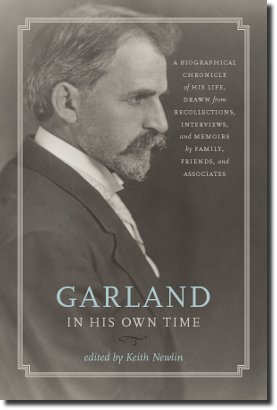 PRAISE "Keith Newlin’s Garland in His Own Time provides a much needed and often fascinating complement to Hamlin Garland’s own voluminous autobiographical writing. Its accounts of Garland’s activities and personality from his teens to his last years, by figures ranging from Walt Whitman and Theodore Roosevelt to Garland's older daughter, are both revealing and incisive in rendering the strengths and weaknesses of this important figure in American literary history. The book will be indispensable for anyone interested in the dimensions and nature of Garland’s career.”—Donald Pizer, Pierce Butler Professor of English Emeritus, Tulane University “Meticulously documented, Garland in His Own Time offers a deeper understanding of Hamlin Garland, the man and the writer, set within the context of the times. These letters and reminiscences are interesting not only in what they divulge about Garland, from the radical youth to the mellow sage, but are fascinating reading in themselves.”—Susanne George Bloomfield, author, Impertinences: Selected Writings of Elia Peattie, a Journalist in the Gilded Age “Keith Newlin has judiciously selected more than sixty reminiscences that help scholars and general readers to better understand Garland’s life, personality, and work. Newlin’s excellent introduction and headnotes contextualize the reminiscences, often revealing how they complement or counter Garland’s own autobiographical accounts. Although an aged Garland lamented his ‘waning fame,’ Newlin, the preeminent scholar on Garland today, has cemented Garland’s legacy in American literary history. No one working on Garland in the future can afford to ignore this collection.”—Paul Sorrentino, Clifford A. Cutchins III Professor of English, Virginia Tech |
Garland in His Own TimeA Biographical Chronicle of His Life, Drawn from Recollections, Interviews, and Memoirs by Family, Friends, and AssociatesEdited and Introduction by Keith Newlin University of Iowa Press, 2013. ISBN:
1-60938-162-9 ABOUT
THE BOOK After realizing he couldn’t make a living from such realistic works, Garland turned first to biography, then to critically panned but commercially popular romances set in the mountain west, and eventually to autobiography. In 1917 he published A Son of the Middle Border, a remarkable autobiography in which he combined the story of his life to 1893 with the story of U.S. westward expansion, to considerable critical acclaim and large sales. Its 1921 sequel, A Daughter of the Middle Border, received the Pulitzer Prize for biography. Although the author eventually wrote no fewer than eight autobiographies, he showed little awareness of the effect of his strong personality upon others. The sixty-six reminiscences in Garland in His Own Time offer an essential complement to his self-portrait by giving the perspectives of family, friends, fellow writers, and critics. The book offers the contemporary reader new reasons to return to this fascinating writer’s work. |
| back |